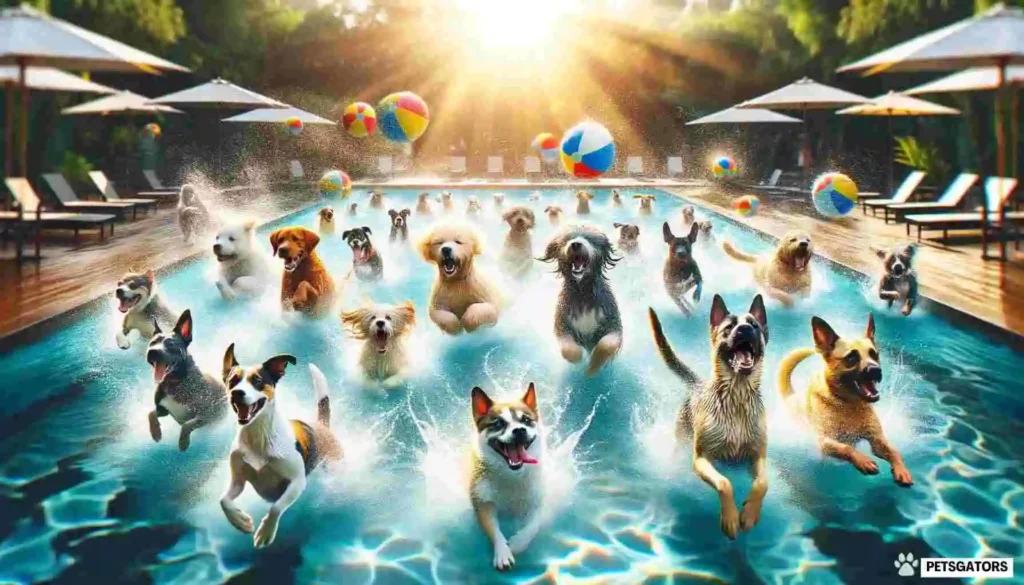Diving into the world of swimming can be as thrilling as it is beneficial, offering a blend of fun, exercise, and relaxation. One of the first strokes many of us encounter, either as children or as adults stepping into the pool for the first time, is the dog paddle. It’s a technique as instinctive as it is iconic, mimicking the way our four-legged friends navigate the water. In this ultimate guide, I’ll walk you through 5 easy steps to master dog paddling swimming, ensuring you have a solid foundation in this essential swimming skill. Let’s make a splash together!

dog paddling swimming
What Is Dog Paddling Swimming?
Dog paddling, often our first encounter with swimming, is a straightforward, beginner-friendly technique. Picture how a dog swims when it hits the water: simple, instinctive movements that keep it afloat. This swimming method involves paddling your hands and kicking your legs in a natural, alternating rhythm. It’s not just for dogs; it’s a great starting point for humans too!
Step 1: Get Comfortable with Water
Before you start paddling away, it’s crucial to become friends with the water. Begin in a shallow area where you can easily stand. Spend some time just moving around, getting a feel for the water’s resistance, and practicing holding your breath. Comfort is key, so take it slow and steady.
Step 2: Practice Floating
Floating is a fundamental skill in swimming, and it’s particularly important for dog paddling. Try lying on your stomach in shallow water, spread your arms and legs slightly, and see if you can float. This might take a few tries, but it’s all part of the learning process. Remember, the more relaxed you are, the more buoyant you’ll become.

dog paddling swimming
Step 3: Start with the Arms
The arm movement in dog paddling is simple: extend your arms in front of you, then alternately move them in a paddling motion, as if you’re scooping the water towards you. Keep your movements gentle and rhythmic. Imagine patting the head of a giant, invisible dog – that’s the kind of motion you’re aiming for.
Step 4: Add the Legs
Once you’re comfortable with the arm movements, it’s time to bring in the legs. Just like the arms, the motion is straightforward. Kick your legs gently, alternating between them, as if you’re walking in the water. The combination of arm and leg movements will keep you afloat and propel you forward.
Step 5: Combine and Practice
Now, it’s time to put it all together. Start paddling with your arms and kicking with your legs in a coordinated effort. Keep your head above water by tilting it slightly upwards, and don’t forget to breathe regularly. It might feel a bit awkward at first, but with practice, you’ll find your rhythm.
Tips for Success
- Stay Relaxed: Tension will make it harder to float and move through the water.
- Breathe Naturally: Work on breathing in a relaxed, rhythmic manner while paddling.
- Practice Regularly: Consistency is key. With each session of practice, your skills will notably improve.
- Have Fun: Remember, swimming is enjoyable. Don’t stress about perfection.
The Benefits of Dog Paddling Swimming
Why consider dog paddling? Here are a few compelling reasons:
- Great for beginners: It’s an excellent way to get comfortable in the water.
- Builds confidence: Helps overcome the fear of swimming.
- Good exercise: Engages multiple muscle groups, providing a decent workout.
- Safe and easy: Low risk of injury due to its natural motion.
Step-by-Step Guide to Dog Paddling Swimming
- Get Comfortable in Water: Start in shallow water where you can stand. Familiarize yourself with the feeling of being in the water, gradually going deeper.
- Breath Control: Learn to hold your breath for a few seconds while your face is in the water. Practice in shallow water, blowing bubbles before lifting your head to breathe.
- The Hand Movement: Extend your arms in front of you, palms down. Alternate moving your arms in a paddling motion, similar to how you’d pat the head of a large dog.
- The Leg Kick: While your hands paddle, your legs should kick in a relaxed, alternating motion, much like walking in water.
- Putting It All Together: Combine the arm and leg movements. Start slow, focus on coordination, and gradually increase your pace as you become more comfortable.
Tips for Mastering Dog Paddling Swimming
- Practice Consistently: Like any skill, regular practice is key.
- Stay Relaxed: The more relaxed you are, the easier it will be to float and move through the water.
- Breathing Technique: Work on your breathing rhythm to ensure it’s consistent and comfortable.
- Watch Videos for Visual Aid: How to Dog Paddle – Swimming Technique and Exercises is a fantastic resource to see the technique in action.

dog paddling swimming
Dog Paddling vs. Other Swimming Techniques
To give you a clearer picture, let’s compare dog paddling with other swimming techniques:
| Technique | Difficulty | Efficiency | Recommended For |
| Dog Paddling | Easy | Low | Beginners, Casual Swimmers |
| Freestyle | Moderate | High | Competitive Swimmers, Fitness |
| Breaststroke | Moderate | Moderate | Fitness, Leisure |
| Butterfly | Hard | High | Competitive Swimmers |
FAQs
Q: Is a doggy paddle effective for swimming?
A: Yes, while it’s not the fastest stroke, it’s effective for staying afloat and moving through water, especially for beginners.
Q: Can all dogs naturally dog paddle?
A: Most dogs instinctively know how to dog paddle, though some breeds are better swimmers than others.
Q: Is doggy paddle easy to learn?
A: Yes, its simplicity and natural motion make it one of the easiest swimming techniques to pick up.
Q: Why is it called a doggy paddle?
A: The technique mimics the way dogs swim, using simple, alternating movements of their legs and arms (or paws).
Is dog paddling good for fitness?
Yes, it engages multiple muscle groups, though it’s less efficient than competitive strokes.
Can all dogs naturally dog paddle?
Most can, but some breeds find it more challenging due to body structure.
Why is it called a doggy paddle?
The technique mimics the way dogs instinctively swim, using a simple paddling motion.
What’s the best way to learn swimming for beginners? Dog paddling is a fantastic start, offering a gentle introduction to water and swimming basics.
Conclusion
Dog Paddling Swimming is a rewarding step in your swimming journey. It not only builds your confidence in the water but also serves as a foundation for learning more advanced strokes. Remember, the key to success is patience, practice, and, most importantly, enjoying the process. Whether you’re swimming for fitness, fun, or relaxation, the ability to dog paddle keeps you safe and afloat. So take these steps to heart, dive in, and enjoy the swim!
Remember, the key to mastering dog paddling, or any swimming technique, lies in patience, practice, and persistence. Don’t rush the process, and enjoy every splash and paddle along the way.
Happy swimming, and don’t forget to check out more tips and techniques, like the “7 Proven Tips To Master Dog Paddle Swim: Ultimate Guide” at petsgators.com for more insights into perfecting your dog paddle swim. See you in the water!







